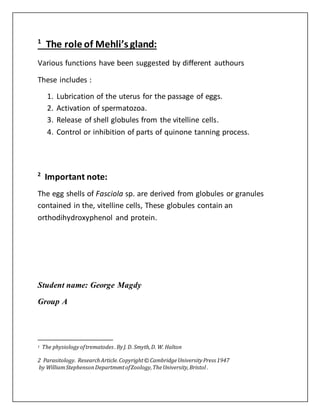Recommended
Recommended
More Related Content
What's hot
What's hot (20)
Supplementation with goat follicular fluid in the in vitro

Supplementation with goat follicular fluid in the in vitro
Mehli's gland
- 1. 1 The role of Mehli’s gland: Various functions have been suggested by different authours These includes : 1. Lubrication of the uterus for the passage of eggs. 2. Activation of spermatozoa. 3. Release of shell globules from the vitelline cells. 4. Control or inhibition of parts of quinone tanning process. 2 Important note: The egg shells of Fasciola sp. are derived from globules or granules contained in the, vitelline cells, These globules contain an orthodihydroxyphenol and protein. Student name: George Magdy Group A 1 The physiologyoftrematodes. ByJ. D. Smyth,D. W. Halton 2 Parasitology. ResearchArticle.Copyright© CambridgeUniversityPress 1947 by WilliamStephensonDepartmentofZoology,TheUniversity,Bristol .
